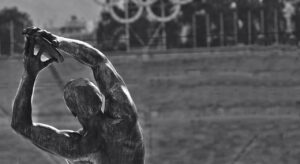As primitive society developed, the clan community, a new form of social organization, emerged. The development of productive forces and the expansion of labor experience led to the complication of education in general and physical education in particular.
Education, like labor, was collective in nature. This helped primitive people to fight hard with nature for their existence, to overcome the harsh hardships of life. Along with farming, cattle breeding and crafts, the military organization of the tribal community began to play an increasingly important role. Physical education in these conditions served the function of training not only for labor activities, but also for military service. The rudiments of military education appeared. So, from an early age Australian aboriginal children practiced archery, throwing various objects, went hunting and fishing together with adults. The primitive Australians were familiar with a variety of games and entertainment. Boomerang throwing and inter-tribal ball games were practiced.
The ethnographer M.M. Miklukho-Maklai, who lived for a long time among the Papuans of New Guinea, describes their games involving running, throwing, archery, jumping, various dance movements. The primitive peoples of the Americas (Indians, Eskimos, etc.) preferred games involving throwing a ball at a target, running long distances, and lifting stones. The primitive tribes of Africa taught children, adolescents and young men stick fencing, wrestling, games with running and jumping, archery, exercises with swinging on vines followed by jumping. The Bushmen tribes were noted for their speed and unique endurance. Men’s games were competitive and their dances were athletic in character.
Rites of initiation (from Latin initiano – the fulfillment of sacraments). The primitive peoples had peculiar ceremonies with pedagogical orientation – initiation (dedications) during the transition from one age group to another, during admission to a clan or tribe, etc. The young people were prepared for initiation by the clan or tribe elders. The purpose of the rite was to accept the young man into the society of full members of the clan if he met certain requirements. Preparing for initiation, the young men trained hard, practiced hardening, observed strict discipline, and took part in hunting. During initiation, subjects had to demonstrate their skills in physical exercises and games (running, jumping, javelin throwing, various types of wrestling).
There were significant differences in the upbringing of boys and girls in the tribal society. Boys and boys played hunting and war games, staged chases and ambushes. Girls and young women engaged in games, dances and exercises reflecting the everyday life and work of women.
Physical exercises and games became an important means of educating the younger generation. Physical education was increasingly prominent in life. It was closely connected with work and life, accessible to all members of the family. Physical culture with elements of physical exercises was the most important part of the general culture of the ancient man.
In the late matriarchal period, physical education of young people was carried out in the process of games of competitive nature, and the games, as a rule, reflected the specific lifestyle of these or those tribes. For example, “Teca” was a widespread game on the Polynesian islands, the main element of which was throwing a spear, dart, or pole at a distance and accuracy. Underwater wrestling was very popular among Polynesians. Its essence was to hold an opponent under water until he recognized himself defeated. The game of ball, made of leather and stuffed with wool, was widespread among the Australians. Depending on the conditions of the game, the ball was thrown and caught with the hands or kicked to see who would get farther.
Among American Indians in the late matriarchy period the game with a rubber ball, somewhat reminiscent of modern soccer, was popular.
Some sources contain information that various styles of swimming similar to crawl and breaststroke, elements of gymnastic exercises on the crossbar, games resembling modern field hockey, and discus throwing exercises were known in the tribal society.



